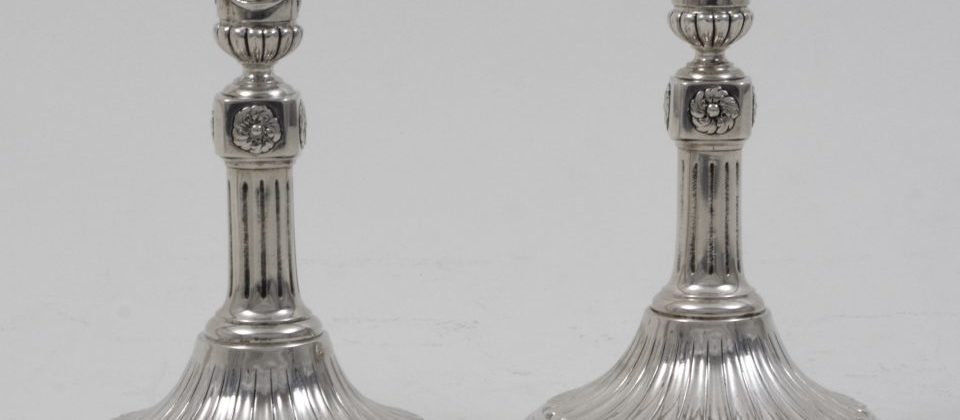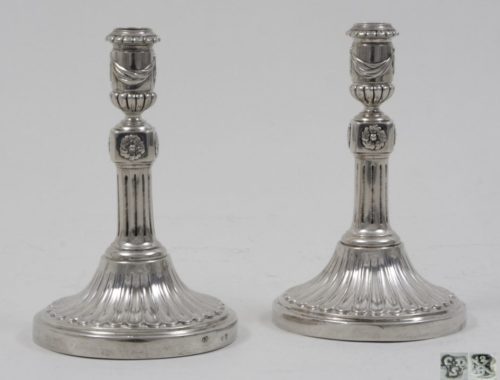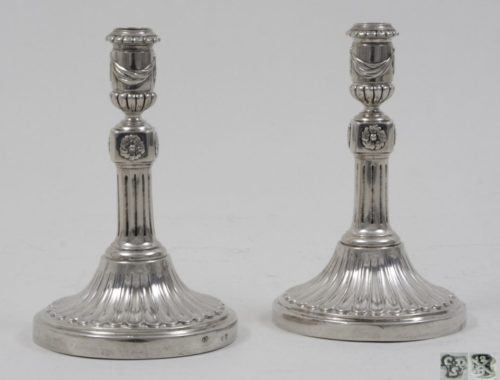Object Number: #720
Dresden, ca. 1783
Maker: Carl David Schrödel
Town hall-mark: for Dresden during the third quarter of 18th century: in a curved shield, the form of a coat of arms with crossed swords, a “D” and the number of fixed fineness. Here, the number “12” at the upper field and the letter “D” at the lower field of the shield (Rosenberg3 no 1674).
Maker: maker’s mark, or rather monogram “C•D/S•” in a curved shield for Carl David Schrödel (Rosenberg3 no 1805 and 1806).
Height: 16 cm (6,3 in.); Weight: each 434 gr.
Detailed Information
This pair of candlesticks is a fine example of the antique-like, or rather neoclassical, style tendencies in the goldsmith art of Dresden. On a wide, round, bell-shaped foot with a décor of lamb’s tongue frieze, a neoclassical shaft is raised upon it. The shaft is square and light fluted. A rosette adorns every one of its four upper sides. The shaft gives an architectural effect. The spout presents the form of a vase, is with plastic flapping decoration and lamb’s tongues adorned and comprises a profiled rand, decorated with lamb’s tongues. The antique-like character of the candlesticks demonstrates very successfully the turn in the works of silver in Dresden, during the second half of the 18th century.
The goldsmith and jewellery art in Dresden has known an important increase in the need for works since the reign of August II the Strong (r. 1694-1733). Under the son and successor of August II the Strong, Frederick Augustus II/Augustus III (r. 1733-1763), the demand for objects of goldsmith and jewellery continues to be important.
The time of Augustus III means the end of the baroque and the prevalence of a new decorative style, the Rococo.
The death of Augustus III and the end of the Seven Years’ War (1756-1763) as well as a new political scene bring also to the arts and crafts changes.
The goldsmith and jewellery art present some of their most elegant creations in 18th century, the luxury, fancy articles, by supporting the developed mineralogy.
Goldsmiths followed and supported the creative work of the porcelain manufacture in Meissen (est. 1710).
Maker: Carl David Schrödel became master probable in 1743. The name Schrödel has been born from a whole family of goldsmiths from Dresden. Carl David Schrödel carries an elegant monogram-mark and he is mentioned in 1762 as jeweller of the court (Rosenberg3 Nr. 1805; Holzhausen 1966: LXXXVIII). Another C. D. Schrödel, mentioned between 1748-1773, is likely the same with Carl David Schrödel (Holzhausen 1966: LXXVIII).
Works from the Schrödels have been artfully and important mostly during the Neoclassic period-style.
Different objects from the Schrödels demonstrate the quality of their work as well as the developments in their art.
Literature:
Holzhausen, W., 1966, Goldschmiede in Dresden. Prachtgefäße, Geschmeide, Kabinettstücke, Tübingen: Verlag Ernst Wasmut
Rosenberg, M., 1923, Der Goldschmiedemerkzeichen, Dritte erweiterte und illustrierte Auflage, Bd. II: Deutschland D-M, Frankfurt a. Main: Frankfurter Verlags-Anstalt [Rosenberg3]




